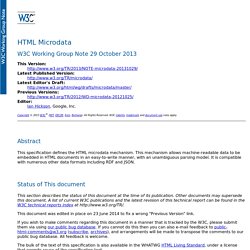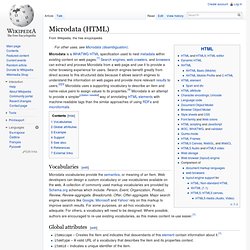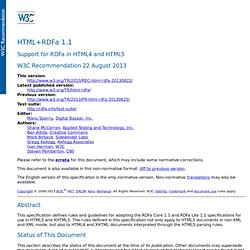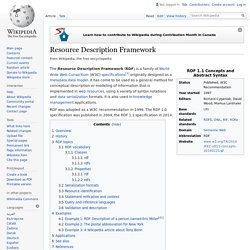

HTML Microdata. Abstract This specification defines the HTML microdata mechanism.

This mechanism allows machine-readable data to be embedded in HTML documents in an easy-to-write manner, with an unambiguous parsing model. It is compatible with numerous other data formats including RDF and JSON. Status of This document This section describes the status of this document at the time of its publication. This document was edited in place on 23 June 2014 to fix a wrong "Previous Version" link.
If you wish to make comments regarding this document in a manner that is tracked by the W3C, please submit them via using our public bug database. The bulk of the text of this specification is also available in the WHATWG HTML Living Standard, under a license that permits reuse of the specification text. Publication as a Working Group Note does not imply endorsement by the W3C Membership. The latest stable version of the editor's draft of this specification is always available on the W3C HTML git repository. Microdata (HTML) Microdata is a WHATWG HTML specification used to nest metadata within existing content on web pages.[1] Search engines, web crawlers, and browsers can extract and process Microdata from a web page and use it to provide a richer browsing experience for users.

Search engines benefit greatly from direct access to this structured data because it allows search engines to understand the information on web pages and provide more relevant results to users.[2][3] Microdata uses a supporting vocabulary to describe an item and name-value pairs to assign values to its properties.[4] Microdata is an attempt to provide a simpler[citation needed] way of annotating HTML elements with machine-readable tags than the similar approaches of using RDFa and microformats. Microdata vocabularies provide the semantics, or meaning of an Item. Web developers can design a custom vocabulary or use vocabularies available on the web.
Here is the same markup with added Schema.org[5][6][7] Microdata: HTML+RDFa 1.1. Status of This Document This section describes the status of this document at the time of its publication.

Other documents may supersede this document. A list of current W3C publications and the latest revision of this technical report can be found in the W3C technical reports index at This document has been reviewed by W3C Members, by software developers, and by other W3C groups and interested parties, and is endorsed by the Director as a W3C Recommendation. It is a stable document and may be used as reference material or cited from another document. This specification is an extension to the HTML5 language. Note There are two features in this specification, @datetime processing and rdf:HTML literals, that are currently defined as non-normative features. A sample test harness is available for software developers. RDFa. RDFa (or Resource Description Framework in Attributes[1]) is a W3C Recommendation that adds a set of attribute-level extensions to HTML, XHTML and various XML-based document types for embedding rich metadata within Web documents. The RDF data-model mapping enables its use for embedding RDF subject-predicate-object expressions within XHTML documents.
It also enables the extraction of RDF model triples by compliant user agents. The RDFa community runs a wiki website to host tools, examples, and tutorials.[2] History[edit] RDFa was first proposed by Mark Birbeck in the form of a W3C note entitled XHTML and RDF,[3] which was then presented to the Semantic Web Interest Group at the W3C's 2004 Technical Plenary.[3] Later that year the work became part of the sixth public Working Draft of XHTML 2.0.[4][5] Although it is generally assumed that RDFa was originally intended only for XHTML 2, in fact the purpose of RDFa was always to provide a way to add a metadata to any XML-based language. <? Resource Description Framework. The Resource Description Framework (RDF) is a family of World Wide Web Consortium (W3C) specifications[1] originally designed as a metadata data model.

It has come to be used as a general method for conceptual description or modeling of information that is implemented in web resources, using a variety of syntax notations and data serialization formats. It is also used in knowledge management applications. RDF was adopted as a W3C recommendation in 1999. The RDF 1.0 specification was published in 2004, the RDF 1.1 specification in 2014. Overview[edit] RDF is an abstract model with several serialization formats (i.e. file formats), so the particular encoding for resources or triples varies from format to format. As RDFS and OWL demonstrate, one can build additional ontology languages upon RDF.
Semantic HTML. Semantic HTML is the use of HTML markup to reinforce the semantics, or meaning, of the information in webpages rather than merely to define its presentation or look.

Semantic HTML is processed by regular web browsers as well as by many other user agents. CSS is used to suggest its presentation to human users. As an example, recent HTML standards discourage use of the tag <i> (italic, a typeface)[1] in preference of more accurate tags such as <em> (emphasis); the CSS stylesheet should then specify whether emphasis is denoted by an italic font, a bold font, underlining, slower or louder audible speech etc. History[edit] HTML has included semantic markup since its inception.[4] In an HTML document, the author may, among other things, "start with a title; add headings and paragraphs; add emphasis to [the] text; add images; add links to other pages; [and] use various kinds of lists".[5] At one time, HTML also included presentational markup such as <font>, <i> and <center> tags.